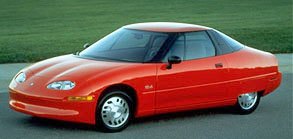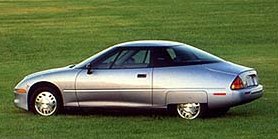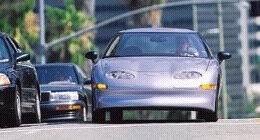  GM EV1 was the world's first attempt to produce electric cars for the mass passenger car market. Interestingly, it was also the first car selling under the "GM" brand instead of any of its divisions, although GM had been existing since 1930s ! The EV1 was developed to satisfy the California State of USA, which had passed a new clean air regulation to require all major car makers must sell at least 10 percent of their vehicles as electric cars - or what they called Zero Emission Vehicles (ZEV) - by 2003. Having demonstrated a prototype called "Impact", GM started selling the production EV1 in 1997. Sorry, it didn't "sell" the car actually. It just leased the EV1 to customers on the basis of a 2-year contract. The lease fee was US$349 to US$574 per month depending on content. Obviously, this could not cover the high production cost, let alone the development cost of US$500 million. The 2-seater coupe format was best suited to the nature of the car. It left a lot of space for the big batteries and relieved the burden on the electric motor. Power came from conventional lead-acid batteries weighting 500 kg. They were placed inside the transmission tunnel and behind the seats. The direct current electricity was converted to AC current by the inverter located under the bonnet and then supplied the 3-phase induction motor underneath the inverter. The motor generated a respectable 137 horsepower from 7000-13000 rpm. As electric motors generate flat torque right from the start (110 lb-ft from 0 to 7000 rpm in this case), the EV1 did not need a gearbox. The motor drove the front wheels via differential.   The EV1 employed aluminum spaceframe chassis and a mixture of plastic and composite body panels to offset the weight of the batteries, resulted in an acceptable 1360 kg kerb weight. Its water drop shape achieved a record-breaking drag coefficient of 0.19, partly thanks to the absence of radiators. Low rolling resistance tires were employed to reduce energy consumption. R&T measured a surprisingly spirited performance - 0-60 mph took 7.9 seconds. Top speed was electronically governed at 80 mph. On the road, the electric motor was turbine-smooth and very quiet. It sounded more like a washing machine. The EV1 rode well, but handling was just average because of the weight and the short of grip. It was an image car rather than a real coupe. People loved it simply because it looked futuristic and represented an environment conscious.    EV1 did not had any breakthroughs in battery technology, however. Its lead-acid battery was not only heavy, but also time-consuming for recharging (normally needed to charge overnight) and had a driving range of just 60-90 miles, even having taken regenerative braking into account. 2 years after launch, GM introduced the second generation EV1 with improved batteries. A larger capacity lead-acid battery supplied by Pansonic now weighed 600 kg and extended range to 80-100 miles. An extra-cost optional Nickel-Metal Hybrid (NiMH) battery extended to 100-140 miles. Note that in reality owners found these figures difficult to achieve, no wonder GM lowered the figures afterwards. As seen, the technology of electric vehicles was not matured enough to compete with conventional cars. Perhaps this was just what GM wanted to demonstrate through the EV1 program. California eventually canceled its ZEV regulation. EV1 had no reasons to exist any more. Only 1,117 were ever produced, about 500 of them were the second generation. As the lease contract expired, all cars returned to GM and were either scrapped or put into museums. Sadly, GM destroyed a potentially valuable collector's car. |